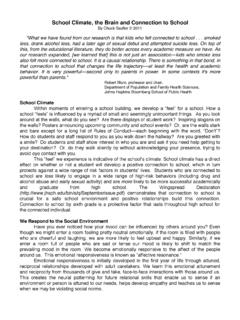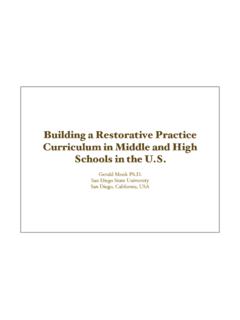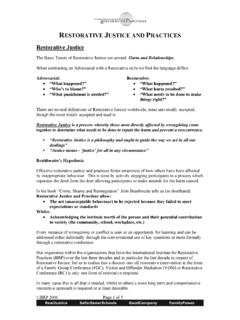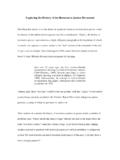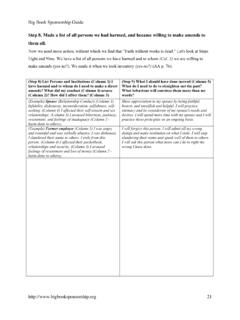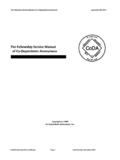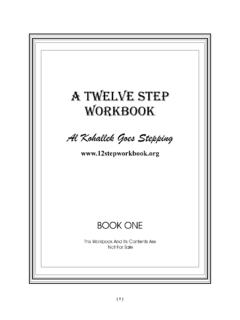Transcription of Applying the Framework: Positive Youth …
1 Applying the Framework: Positive Youth development and RestorativePracticesNancy Riestenberg, Prevention Specialist, MN Department of EducationThe principles and philosophy of restorative measures are congruent with many programs andcurricula that teach social emotional learning and classroom and behavior management. restorative practices circles to repair harm or restorative group conferences, as well as familygroup decision making and restorative peer juries give educators an effective means of helpingstudents practice the social skills they have been taught, under real and significant circumstances. When students have a vested interest in a fight or bullying situation, either as a victim, offenderor bystander, they will learn more deeply as they practice repairing harm, communicatingfeelings, and problem measures can be aligned with the broader area of healthy Youth development , as ameans of implementing the elements Youth need to engage as they grow to adulthood.
2 TheKonopka Institute for Adolescent Health uses Dr. Gisela Konopka s lifetime study of Youth andtheir developmental needs to present a framework for working with Youth , as well as a list ofcommon components for successful Youth programs. This paper will discuss schoolconnectedness, formal school discipline practices and their outcomes, and through a series ofstories, examine restorative measures and Positive Youth development to illustrate the strengths ofboth. Finally, recommendations for school and Youth programs regarding restorative measureswill include suggestions for future research and Connectedness and School DisciplineResiliency research looks for elements in adolescents lives that contribute to their strengths,assets and protective factors. One of the largest such studies were done by the Center forPopulation Options in collaboration with the University of Minnesota. The National LongitudinalStudy on Adolescent Health, otherwise known as AddHealth, analyzed data from some 90,000students across the nation, administrators of the schools the students attended, and 18,000 of theirparents.
3 Findings indicated two broad concepts: family connectedness makes a difference in thelives of Youth and school connectedness makes a difference in the lives of Youth (p 7; Blum &Rinehart). Students easily feel connected to school when the student never gets into trouble or has conflictwith other Youth . But it is more difficult to feel or maintain connection when a student is at oddswith others on a continual basis, or when the student is victimized, but the victimization is notaddressed. The challenge for educators is to maintain connection with Youth while holding themaccountable for misdeeds or harm, and to support those that have been harmed throughmeaningful school connectedness is an indicator of student health, typical school disciplinary practicesrely heavily on exclusion. Formal discipline of suspensions, detention, exclusion and expulsionundermine the possible connections between the excluded student and the adults and otherstudents in the school building.
4 In a 1998 study by Costenbader and Markson on schoolsuspensions, they summarized research on the effects of in- and out-of-school suspensions. Serious negative outcomes of out-of-school suspension included: An increase in maladaptive behaviors not addressed by the suspension; Withdrawal or avoidance of school staff; A negative impact on self respect; A stigma among peers; Driving a school problem into the streets and community Disruption of education progress, and Loss of state aid based on average daily suspension has been correlated with drug use, poor academic achievement, graderetention and long-term disaffection and alienation. Costenbader and Markson s own researchshowed that students who had been suspended were more likely to be involved with the legalsystem. restorative measures, however, look not at rule violations but at the violation of relationships,and seek to hold the Youth responsible to the persons who have been harmed and/or have beenaffected, challenging all to repair the relationships.
5 Howard Zehr, in The Little Book ofRestorative Justice, describes wrongdoing as ..a violation of people and interpersonalrelationships. Violations create obligations. The central obligation is to put right the wrong ( : Zehr). The person who did the harm, the person harmed and the community classmates,bystanders, staff and family members work together to put right the wrong. There are several restorative practices used in school, such as restorative conferencing, circles torepair harm and restorative peer juries. Ideally, the person who was harmed, the person who didthe harm, and the community other affected parties, classmates, bystanders, friends, staff,family members, elders or neighbors come together in a facilitated process to talk about theharm and how people were affected by it, to identify needs and obligations as a result of the harm,to identify possible solutions, and to come to agreement through consensus. The agreementshould include restitution, reconciliation and resolution, as well as provide support for the victimor for the offender.
6 In a conference, the facilitator is called a facilitator; in a circle the facilitatoris a keeper; and with peer juries, the members of the jury trained students together facilitatethe The Little Book of restorative Discipline in Schools, Lorraine Stutzman Amstutz and Judy provide the following principles of restorative discipline: relationships are central to building community; focus on harm done rather than on rule-breaking; give voice to the person harmed; engage in collaborative problem-solving; empower change and growth and enhance responsibility (p 26-28).These themes are echoed in healthy Youth development Youth DevelopmentIn 2000, the Konopka Institute for Best practices in Adolescent Health published the monographGrowing Absolutely Fantastic Youth . It summarized the research on adolescent development andprovided a framework for healthy Youth development which can help guide discipline practices inboth schools and Youth programs. When using Gisela Konopka s Requirements of Healthy YouthDevelopment, restorative discipline can provide Youth with opportunities for healthy adolescentdevelopment.
7 Dr. Konopka asserted that all young people need to: Participate as citizens, as members of a household, as workers, as responsible members ofsociety; Gain experience in decision-making; Interact with peers and acquire a sense of belonging; Reflect on self in relation to others and to discover self by looking outward as well asinward; Discuss conflicting values and formulate their own value system; Experiment with one s own identity, with relationships; try out various roles without havingto commit oneself irrevocably; Develop a feeling of accountability in the context of a relationship among equals; Cultivate a capacity to enjoy life; and Participate in the creative arts, to learn self-expression and communicate deeper feelingsfrom within (p 20).In formal school discipline situations, when a student violates a rule, adults often talk about howthe student has lost privileges or the right to participate in school, activities, and class trips.
8 Students often lose the right to make decisions (conveyed by the principal via the studenthandbook), and at least for a time being, the right to participate as a responsible member of theschool society. With a restorative response, however the student does not lose the chance forpositive Youth development . The list above is, in fact, a list of all that could happen in aconference or circle to repair harm. Youth participating in a restorative process are part of the decision-making process, discussingand coming to consensus about making amends, giving back to the community, makingrestitution and outlining a plan for improving behavior. restorative justice participants theperson who did the harm, the person harmed, community members, friends are operating as aresponsible members of society. A responsible person recognizes when she has done harm andworks to repair that harm. A responsible person offers his knowledge and insight to solve Zehr identifies needs for victims, offenders and community.
9 He lists victim needs forinformation, truth-telling, empowerment, restitution or vindication. Offenders needaccountability, encouragement to experience personal transformation, encouragement and supportfor integration into the community and for some, at least temporary restraint. Thecommunity classmates, bystanders, staff, family members need attention to their concerns asvictims, opportunities to build a sense of community and mutual responsibility, andencouragement to take on their obligations for the welfare of their (p 14-18: Zehr). Both victims and offenders are in need of Positive interaction with peers and acquiring a sense ofbelonging, albeit for different reasons. Being a victim of harm or crime sets a person apart, andreceiving messages of care and concern helps to bring the victim back into the community. Victimization can also feel dis-empowering, and having the chance to articulate what one needsto be safe or what restitution would be acceptable helps increase the Youth s sense of personalpower.
10 In addition, helping to repair the harm, whether you are the victim, the offender or thebystander can increase all participants sense of agency . I can make a difference in the worldby helping to develop clear, specific agreements in a conference or circle to repair harm. Healthy Youth development Through restorative MeasuresMembership, accountability, and decision-makingI share three stories to illustrate the application of restorative measures as a thoughtful means offurthering healthy adolescent development in students. Oscar Reed, Circle keeper and trainer, hasworked in the Minneapolis Public Schools, and tells this principal of one of the middle schools with whom we collaborate asked me to facilitate aCircle for nine members of the school s basketball team. Recently, they had done considerabledamage to an opposing team s locker room. The principal felt that it would be too easy tosuspend them, which is what the students expected, and valuable lessons would be attendance for the Circle were parents, social workers, teachers, the basketball coach, theschool s police liaison and the maintenance engineers.

